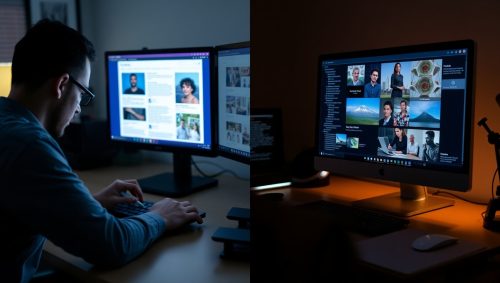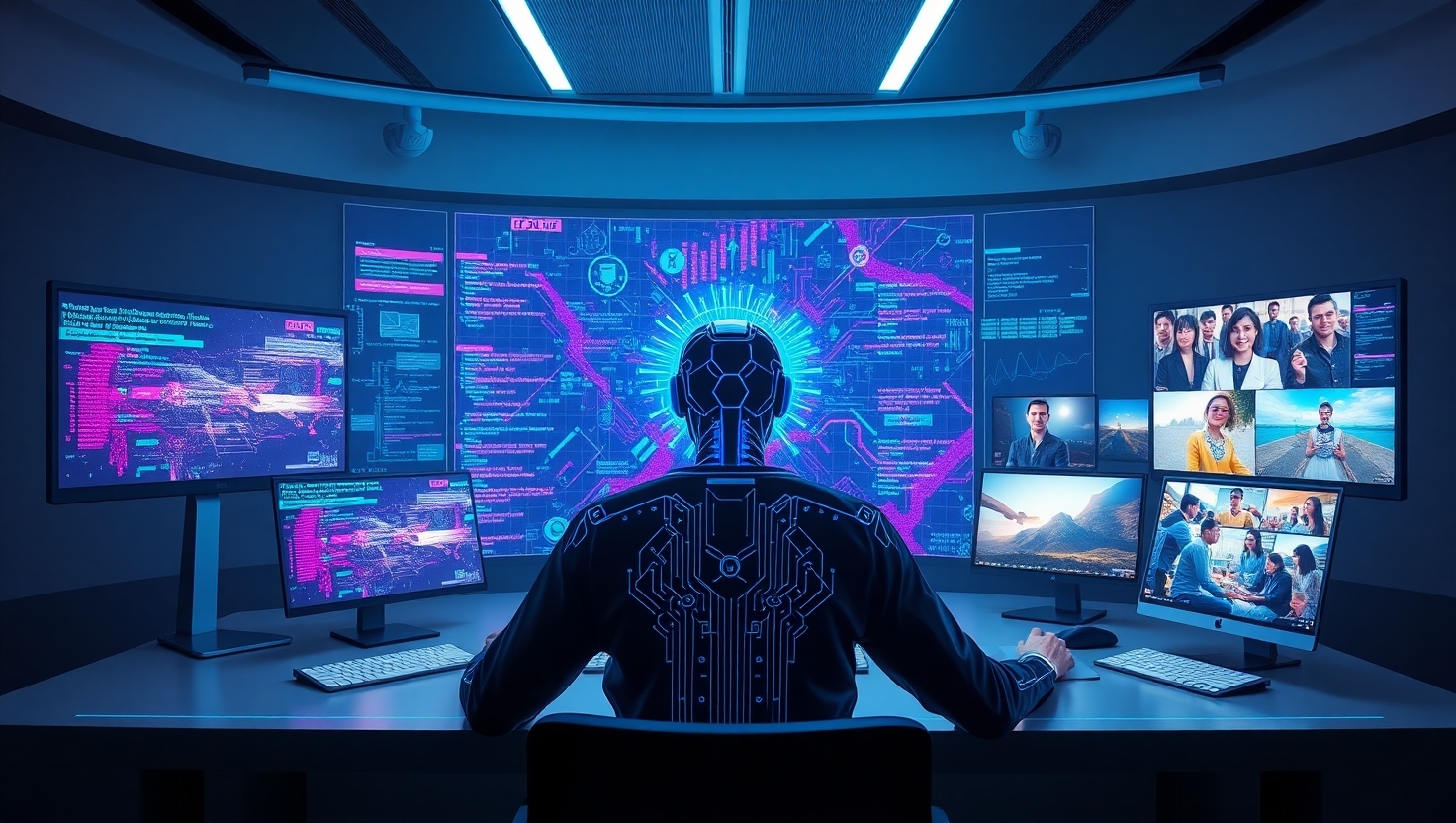Artificial intelligence (AI) is rapidly transforming how we create content. A new generation of AI content creation tools is emerging for text, image, video, and voice, making it easier than ever to produce high-quality content with a bit of help from algorithms. In marketing and media, AI-powered tools can now draft blog posts, design graphics, edit videos, or even generate human-like voiceovers in a fraction of the time it used to take.
In fact, recent research shows AI-generated articles are produced 5× faster than manual writing and that AI-assisted blog posts receive 32% higher engagement on average.
It’s no wonder the AI content creation market is booming – projected to grow from $2.9 billion in 2024 to $3.53 billion in 2025. Whether you’re a marketer, blogger, small business owner, student, content creator, or agency, this beginner-friendly guide will walk you through the fundamentals of AI content creation tools across text, image, video, and voice, and how to leverage them effectively.
As AI becomes more accessible, these tools are empowering users to generate content faster, at lower cost, and often with impressive quality. Below, we break down four key categories of AI content creation tools – text, image, video, and voice – highlighting popular tools in each category, their unique strengths, and best use cases. You’ll also find tips on choosing the right tools for your needs, best practices for using AI in content creation, and answers to common FAQs. Let’s dive in!
AI Text-Based Content Tools (AI Writing Assistants)

Text-based AI tools use powerful language models to generate written content from natural language prompts. They can help brainstorm ideas, write and edit drafts, create marketing copy, translate languages, and more. .
- ChatGPT (OpenAI): A versatile conversational AI based on GPT models that can produce everything from blog articles to code. It’s known for its detailed, context-rich responses and is great for brainstorming, Q&A, and drafting content.
Use case: Getting quick first drafts of articles, answering research questions, or generating creative story ideas in a conversational style. (Free and paid versions available, with GPT-4 offering more advanced capabilities.) - Claude (Anthropic): A competitor to ChatGPT, Claude is designed to be helpful, honest, and harmless. It has a very large context window, meaning it can handle long documents or transcripts and still provide relevant output.
Use case: Summarizing long reports, analyzing lengthy text, or engaging in extended Q&A where keeping context is important. Claude tends to stick closely to user instructions, making it good for detailed guidance and iterative writing. - Jasper AI: A commercial AI writing tool tailored for marketing content. Jasper comes with templates and tone settings for blog posts, social media captions, ad copy, emails, and more. It often integrates GPT-3/GPT-4 under the hood, but its interface is user-friendly for non-technical users.
Use case: Quickly generating marketing copy with the right tone (e.g. a friendly social media post, or a persuasive product description) by filling in a template. Jasper’s strength is consistency and ease of use for businesses looking to scale content. - Copy.ai: Another popular AI copywriting assistant that helps create content for advertisements, product descriptions, brainstorming taglines, and even generating blog ideas. It’s known for saving time on creative copy tasks by providing multiple variations to choose from.
Use case: When you need a bunch of headline options, social media post ideas, or quick blocks of copy, Copy.ai can deliver suggestions in seconds. It’s favored by many marketers to overcome “writer’s block” with fresh ideas.
AI Image Generation Tools (Text-to-Image)
![]()
If you’ve ever needed a graphic or illustration but lacked design skills, AI image generators can be a game changer. AI image generation tools create original images based on text prompts or other images. Powered by generative adversarial networks and diffusion models, they can produce everything from artwork and concept designs to marketing visuals in minutes. This opens up huge possibilities for bloggers, marketers, and designers to get custom graphics without hiring a photographer or artist.
Some of the leading AI image tools include:
- MidJourney: An AI image generator renowned for its stunning, high-quality art and photorealistic images. MidJourney operates through a Discord server where users input text prompts (and can include example images) to get four image variations in return. It’s highly popular among digital artists and content creators for its creativity – you can generate everything from fantasy landscapes to realistic portraits.
- DALL·E 3 (OpenAI): DALL·E is OpenAI’s image generation model that can produce imaginative images from detailed descriptions. The latest version, DALL·E 3, is better at understanding complex prompts and rendering fine details (it’s even integrated into ChatGPT for interactive prompt refining).
- Leonardo AI: An up-and-coming image generation platform that offers a user-friendly interface and a variety of pre-trained models/styles. Leonardo.ai is noted for allowing users to train custom models (by uploading a set of images to teach a specific style or subject).
AI Video Creation Tools (Text-to-Video and Video Editing)
Video content is booming, and AI hasn’t been left behind in this arena. AI video creation tools can help generate or edit videos with minimal manual work. This includes everything from turning a script into an animated video, to swapping backgrounds, to creating talking avatar videos. By leveraging AI, even small teams can dramatically increase their video output – one study found AI-powered video generation can boost content output by 4× and cut production costs by 80%
. Here are some notable AI video tools and what they offer:
- Pika Labs: Often just called Pika, this tool enables text-to-video generation. You enter a description or storyboard in text, and Pika creates a short video or animated sequence to match. It can also do image-to-video conversion, animating static images or replacing elements in existing footage (a feature called “Pikaswap” lets you swap anything in a video with something else via a prompt) pika.art
Use case: Content creators can use Pika to generate quick illustrative clips – for example, to bring an infographic to life or create B-roll footage from a concept. It’s great for social media clips or adding creative animations without learning complex software.
- Runway ML: Runway is a suite of AI creative tools, and it’s at the forefront of AI video editing. It gained fame for its Gen-2 model which generates short video clips purely from text prompts (imagine typing “a cat flying through space” and getting a video of it). Besides generation, Runway’s tools can remove backgrounds, upscale video, and apply effects using AI.
Use case: Marketers can quickly remove or change video backgrounds for ads, or filmmakers can pre-visualize scenes with text-to-video mockups. Runway is like an AI Swiss army knife for video and is user-friendly via its web interface.
- Kling: Developed by the Kuaishou AI team, Kling is a powerful text-to-video generator capable of producing high-definition videos from prompts
It’s known for a more cinematic output – users have noted it can create 1080p videos that look like short film clips.
Use case: If you need a short promotional video or a stylized cinematic clip (for instance, an intro sequence with specific imagery and movement), Kling aims to deliver that from just your written scenario. It’s still an emerging tool, but early users rave about the visual quality for things like concept trailers or dynamic story visuals.
- HeyGen: A leader in the AI avatar video space, HeyGen lets you create videos with realistic human presenters generated by AI. You can pick a virtual spokesperson (or even create a custom avatar), input a script, and have the avatar recite it in a lifelike manner. It also supports features like swapping the avatar’s language (dubbing the video in different languages with the same avatar’s voice/mouth synced).
Use case: Businesses making training videos, product explainers, or personalized sales videos can use HeyGen to get a professional-looking presenter video without hiring actors or camera crews. It’s a direct competitor to tools like Synthesia, offering an easy way to generate talking-head videos for content marketing or e-learning.
AI Voice and Audio Tools (Voice Generation)
Finally, let’s talk about voice and audio. AI voice generation tools can produce natural-sounding speech from text, clone voices, or even create background music and sound effects.In content creation, this means you can add professional narration to your video or podcast without hiring a voice actor, often saving time and money. In fact, using AI voiceovers can save up to 70% of production time compared to recording audio manually.
Here are a few notable AI voice tools making waves:
- ElevenLabs: Arguably one of the most advanced text-to-speech platforms, ElevenLabs specializes in ultra-realistic voice synthesis. You can type in text and choose from a range of highly natural voices, or even clone a voice with a small audio sample. It supports over 20 languages and can capture emotions and intonations surprisingly well
- Murf AI: A popular AI voice generator known for its extensive library of voices and easy-to-use studio. Murf offers 120+ voices in 20+ languages, with features to adjust tone, pitch, and speed. It even includes a built-in video editor so you can sync voiceovers directly with visuals.
How to Choose the Right AI Tool for Your Needs
With so many AI content tools available, how do you pick the right one? Here are some tips and criteria to consider:
- Identify your content goals
- Ease of use vs. flexibility
- Budget and usage limits
- Quality and style of output
Conclusion

In this beginner’s journey through AI content creation tools, we’ve seen how AI can assist in writing text, generating images, producing videos, and voicing content. The key points to remember are that AI is here to augment your creativity and productivity, not replace it. These tools can save you time (sometimes cutting tasks from hours to minutes), open up new possibilities (create content types you couldn’t before), and reduce costs – all while maintaining or even enhancing quality when used wisely.
In closing, the growing importance of AI content tools cannot be overstated. Embracing them early can give you a competitive edge, but remember that the human touch remains vital. The best outcomes happen when you combine AI’s speed and data-driven insights with your own creativity, domain knowledge, and empathy for the audience. The future of content is a collaboration between human and machine, and getting started now will prepare you for the even more advanced tools on the horizon.
FAQs (Frequently Asked Questions)
Q: What are AI content creation tools?
A: AI content creation tools are software platforms that use artificial intelligence to generate content (text, images, video, or audio) based on user inputs or prompts. In other words, they leverage AI models – like natural language processing for text or generative neural networks for visuals – to produce content similar to what a human might create
Q: Are AI-powered content tools just for tech experts or can beginners use them?
A: Today’s AI tools are designed with user-friendliness in mind and are absolutely usable by beginners. Many have simple interfaces where you just enter plain language prompts or fill in blanks.
Q: Can AI tools really create quality content on par with human creators?
A: AI has gotten impressively good, but it works best as a collaborator rather than a solo act.
Q: Will using AI-generated content hurt my SEO or get me penalized by Google?
A: This is a common concern ever since AI writing became popular. The short answer: No, not if you use it properly.
Q: How do AI image generators and video tools work – do I need to know design or animation to use them?
A: Surprisingly, you don’t need traditional design or animation skills to use these tools. AI image generators (like MidJourney or DALL·E) work via text prompts.
Q: Can AI replace human content creators entirely?
A: This is a big question on a lot of minds! The consensus so far is that AI is more of an assistant than a replacement for human creators.

